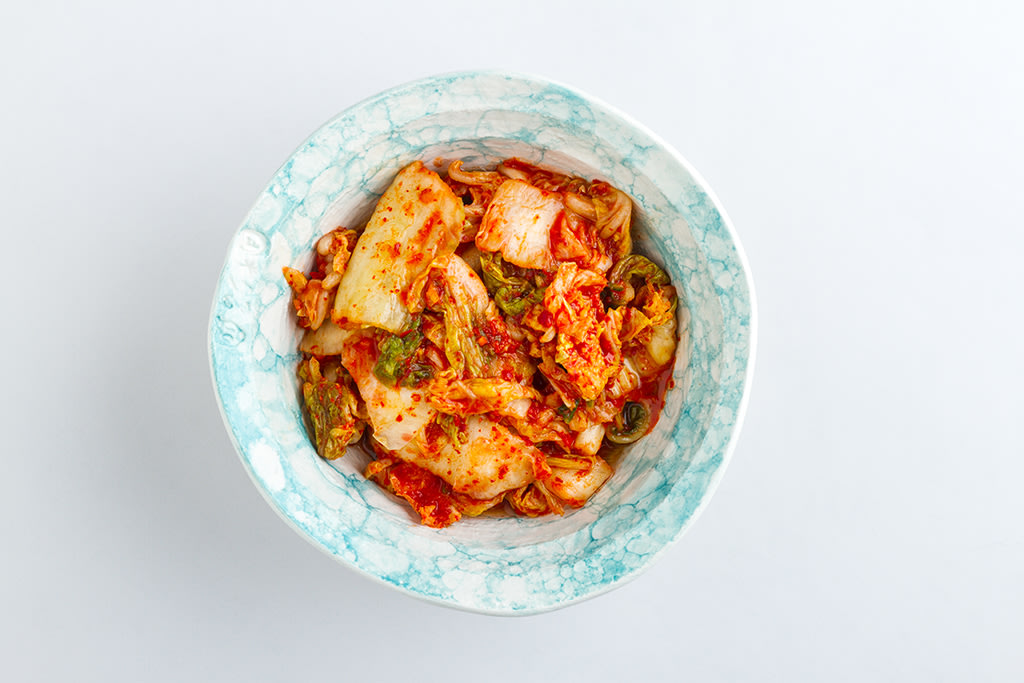How To Make Kimchi

January 19, 2018

If you’re a fan of Korean food, or of fermented foods, then you might have already tried Kimchi. For those of you that haven’t, there are so many reasons to think about using it in your kitchen. Let’s take a look at what it is, how to make it AND how to use it.
Kimchi is a traditional Korean dish. While there are hundreds of different kimchi varieties, the basics are usually the same: seasoned vegetables and salt. Some of the popular varieties are spicy, often using Gochujaru, a Korean chilli powder. While traditionally, kimchi uses seafood flavourings, there are also ways to make the dish vegetarian-friendly too!
Because kimchi is made through the process of fermentation, it can be a natural source of probiotics. This can naturally improve digestion by balancing the level of good bacteria in the gut. Try this recipe if you want to make kimchi at home!
Ingredients (makes enough to fill a 500g jar):
½ Chinese cabbage (wombok)
1½ tbsp sea salt
2 garlic cloves, crushed
2cm fresh ginger, grated
1 tbsp fish sauce
2 tsp maple syrup
2 tsp rice vinegar
1-3 tbsp gochujang (Korean red pepper flakes) or sriracha (chilli sauce)
100g daikon (Korean radish), cut into matchsticks
1 large carrot, peeled and cut into matchsticks
2 spring onions, finely sliced.
Method:
Cut the cabbage in half lengthways and remove the core. Slice into 3 cm strips.
Place the cabbage and salt in a large mixing bowl. Gently mix the cabbage and salt together using your hands, until the cabbage starts to soften a little. Cover the cabbage with water, place a plate on top and weigh it down with something heavy, like a tin of beans. Set aside for 1- 2 hours.
Rinse the cabbage under cold running water and drain well. Place in a large clean bowl and set aside.
Whisk the garlic, ginger, fish sauce, maple syrup and rice vinegar together in a small bowl. Add 1 tablespoon of gochujang (or chilli sauce) for a mild flavour or 3 tablespoons for spicy and mix well to combine.
Add the daikon (radish), carrot and spring onions to the bowl containing the cabbage and mix well to combine. Add the seasoning paste and mix thoroughly to combine, ensuring that all the vegetables are well coated.Tip: Wear gloves to protect your hands from the colour stain and smell!
You can serve the kimchi straight away or pack it into a clean sterilised jar, ensuring that the vegetables are covered with the brine, leaving a 3 cm gap from the top of the jar. Set aside at room temperature 1-2 days to ferment. Store in the refrigerator for up to 2 weeks.
Using kimchi
There are SO many ways you can use kimchi. Add it to scrambled eggs for a little bit of a kick. Pile some into a rice bowl with fresh veggies. Top some toasted sandwiches with kimchi, or add it to your favourite stew.
Kimchi is a kind of salty, acidic base that works really well with rice and noodles, but you can try it out with anything!

A more empowered you starts with Sweat, and our editorial team is here to bring you the latest fitness tips, trainer recommendations, wellbeing news, nutritional advice, nourishing recipes and free workouts.
* Disclaimer: This blog post is not intended to replace the advice of a medical professional. The above information should not be used to diagnose, treat, or prevent any disease or medical condition. Please consult your doctor before making any changes to your diet, sleep methods, daily activity, or fitness routine. Sweat assumes no responsibility for any personal injury or damage sustained by any recommendations, opinions, or advice given in this article.
Nutrition